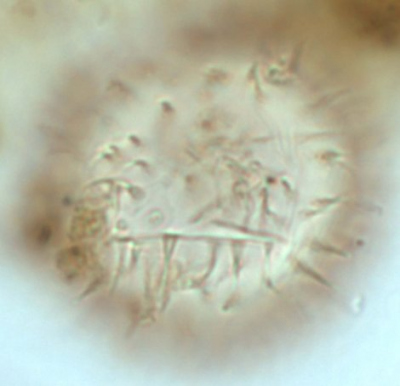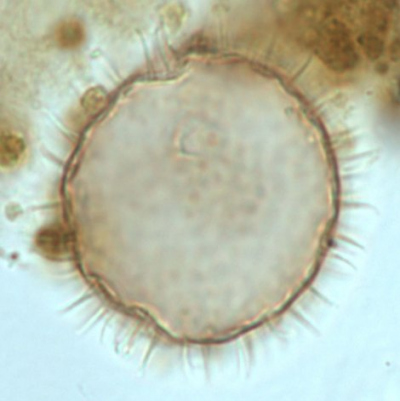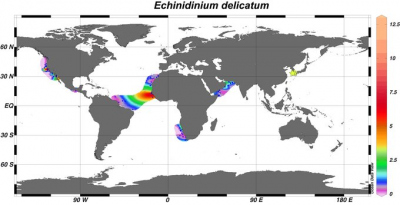Die Inhalte dieser Seite sind leider nicht auf Deutsch verfügbar.
Seitenpfad:
Echinidinium delicatum
Zonneveld, K.A.F. and Pospelova V. (2015). A determination key for modern dinoflagellate cysts. Palynology 39 (3), 387- 409.


dorsal view Holotype
Photographs by Karin Zonneveld
locality: Arabian Sea
cross section
Field characteristics
Echinidinium delicatum (Zonneveld 1997) Head 2003
Characteristics:
Spheroidal pale brown cysts covered with numerous more or less regularly distributed spines. Cyst wall is has a smooth pedium. The rigid, hollow spines are formed by separation of the smooth luxuria and pedium. They are acuminate, pigmented, have (sub) sphaerical bases and are sharply pointed and closed at their distal ends. The chasmic archeopyle consist of a split along one or two sutures.
Dimensions: Cyst body diameter: 17 to 25 µm; length of processes: 2 to 4 µm.
Motile affinity: Unknown.
Stratigraphic range: late Pleistocene to Recent
Comparison with other species:
This is the most difficult species and probably often mixed up with other species. Furthermore this cyst species includes probably cysts of several “motile” species. The distinguishing characteristics are the small cyst size, processes are hollow and tapered,they are all of the same size and are regularly distributed. It most closely resembles cysts of Oblea acanthocysta but differs from this species in having an archeopyle formed by a split along one or two sutures rather than a zig-zag split that encircles the cyst body approximately 2/3 or 3/4th of the cyst. Furthermore E. delicatum has a smaller cyst body diameter compared to a cyst of O. acanthocysta.
Characteristics:
Spheroidal pale brown cysts covered with numerous more or less regularly distributed spines. Cyst wall is has a smooth pedium. The rigid, hollow spines are formed by separation of the smooth luxuria and pedium. They are acuminate, pigmented, have (sub) sphaerical bases and are sharply pointed and closed at their distal ends. The chasmic archeopyle consist of a split along one or two sutures.
Dimensions: Cyst body diameter: 17 to 25 µm; length of processes: 2 to 4 µm.
Motile affinity: Unknown.
Stratigraphic range: late Pleistocene to Recent
Comparison with other species:
This is the most difficult species and probably often mixed up with other species. Furthermore this cyst species includes probably cysts of several “motile” species. The distinguishing characteristics are the small cyst size, processes are hollow and tapered,they are all of the same size and are regularly distributed. It most closely resembles cysts of Oblea acanthocysta but differs from this species in having an archeopyle formed by a split along one or two sutures rather than a zig-zag split that encircles the cyst body approximately 2/3 or 3/4th of the cyst. Furthermore E. delicatum has a smaller cyst body diameter compared to a cyst of O. acanthocysta.
Geographic distribution
Geographic distribution based on:
Zonneveld et al., 2013. Atlas of modern dinoflagellate cyst distribution based on 2405 datapoints. Review of Palaeobotany and Palynology, v. 191, 1-197.
E. delicatum can be observed in temperate to equatorial eutrophic coastal regions that are generally characterised by well mixed upper waters such as upwelling regions. In these regions bottom waters are hypoxic to well-ventilated.
Zonneveld et al., 2013. Atlas of modern dinoflagellate cyst distribution based on 2405 datapoints. Review of Palaeobotany and Palynology, v. 191, 1-197.
E. delicatum can be observed in temperate to equatorial eutrophic coastal regions that are generally characterised by well mixed upper waters such as upwelling regions. In these regions bottom waters are hypoxic to well-ventilated.

Distribution:
The distribution E. delicatum is almost completely restricted to the coastal environments of temperate to equatorial regions. Highest relative abundances (up to 11%) occur in the vicinity of active upwelling cells off North America, NW Africa, SW Africa and the Arabian Sea. It also has been reported with low relative abundances in few sites from the Amazon River Plume.
Environmental parameter range:
SST: 8.6 - 29.4°C (winter - summer) except for one site in in the northeastern Pacific with SST -1.3, -0.8, 4.4 and -0.8°C (Winter, spring, summer, autumn), SSS: 32.2 - 36.7 (summer - summer) except for a few sites with SSS is seasonally reduced to 24.1 in summer, [P]: 0.1 - 1.1 μmol/l, [N]: 0.07 - 8.8 μmol/l, chlorophyll-a: 0.07 - 14.7 ml/l, bottom water [O2]: 0.3 - 6.1 ml/l.
The species has been reported mainly from upwelling regions where large inter-annual variability in the trophic state of the upper waters occurs with eutrophic conditions during active upwelling or when upwelling filaments cross the site and with oligotrophic conditions when upwelling is absent. The species is most abundant in regions with hypoxic bottom waters.
Comparison with other records:
Additional to the regions covered by the Atlas, E. delicatum has also been reported from unstratified and partly strongly nutrient enriched coastal bays in southern South Korea (Pospelova and Kim, 2010). In coastal bays of Southern Vancouver Island highest relative abundances occur at sites with the highest nutrient concentrations (Krepakevich and Pospelova, 2010). Highest cyst production in this area occurs in summer when SSS is relative low and influence of the Fraser river is relative high (Pospelova et al., 2010a). In the nearby Saanich Inlet production is increased when SST and diatom production are increased (Price and Pospelova, 2011). In the upwelling areas of the Arabian Sea and off NW Africa cyst production occurs during active upwelling (Zonneveld and Brummer, 2000; Zonneveld et al., 2010).
The distribution E. delicatum is almost completely restricted to the coastal environments of temperate to equatorial regions. Highest relative abundances (up to 11%) occur in the vicinity of active upwelling cells off North America, NW Africa, SW Africa and the Arabian Sea. It also has been reported with low relative abundances in few sites from the Amazon River Plume.
Environmental parameter range:
SST: 8.6 - 29.4°C (winter - summer) except for one site in in the northeastern Pacific with SST -1.3, -0.8, 4.4 and -0.8°C (Winter, spring, summer, autumn), SSS: 32.2 - 36.7 (summer - summer) except for a few sites with SSS is seasonally reduced to 24.1 in summer, [P]: 0.1 - 1.1 μmol/l, [N]: 0.07 - 8.8 μmol/l, chlorophyll-a: 0.07 - 14.7 ml/l, bottom water [O2]: 0.3 - 6.1 ml/l.
The species has been reported mainly from upwelling regions where large inter-annual variability in the trophic state of the upper waters occurs with eutrophic conditions during active upwelling or when upwelling filaments cross the site and with oligotrophic conditions when upwelling is absent. The species is most abundant in regions with hypoxic bottom waters.
Comparison with other records:
Additional to the regions covered by the Atlas, E. delicatum has also been reported from unstratified and partly strongly nutrient enriched coastal bays in southern South Korea (Pospelova and Kim, 2010). In coastal bays of Southern Vancouver Island highest relative abundances occur at sites with the highest nutrient concentrations (Krepakevich and Pospelova, 2010). Highest cyst production in this area occurs in summer when SSS is relative low and influence of the Fraser river is relative high (Pospelova et al., 2010a). In the nearby Saanich Inlet production is increased when SST and diatom production are increased (Price and Pospelova, 2011). In the upwelling areas of the Arabian Sea and off NW Africa cyst production occurs during active upwelling (Zonneveld and Brummer, 2000; Zonneveld et al., 2010).


